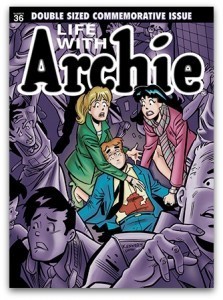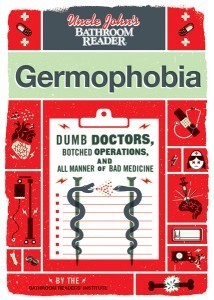Bathroom Readers' Institute's Blog, page 140
April 21, 2014
Ask Uncle John Anything – From Down in the Trenches
Uncle John knows pretty much everything—and if he doesn’t, he heads his massive research library, or puts one of his many associates on the case. So go ahead: In the comments below, ask Uncle John anything. (And if we answer your question sometime, we’ll send you a free book!) This week’s question comes from reader Matthew P., who asks…
How did trench coats get their name? Were they really used for trenches at one time?
 When you see a trench coat, you probably don’t think of World War I, the war known for its bloody, muddy “trench warfare.” But long before Humphrey Bogart and other classic movie stars made them the unofficial clothing of detectives and mystery men, the trench coat really did originate during World War I.
When you see a trench coat, you probably don’t think of World War I, the war known for its bloody, muddy “trench warfare.” But long before Humphrey Bogart and other classic movie stars made them the unofficial clothing of detectives and mystery men, the trench coat really did originate during World War I.
A trench coat is essentially a long, fabric-made raincoat that covers the body from neck to heel. They’re generally tan or beige, include belt loops and a belt, have ten-buttons, and are double breasted. The trench coat hasn’t changed all that much in the past century.
In the 19th century, British and French troops commonly wore serge coats – thick, woven, twill-like coats. They were hot, heavy, and didn’t so much deflect moisture so much as absorb it. The British army adopted trench coats, likely following a design submitted by Thomas Burberry at the turn of the 20th century. The key to Burberry’s design: a fabric of his own invention called gabardine, a predecessor to the fabrics used to make modern-day pants like khakis, or chinos. Unlike serge, gabardine was so tightly woven that it effectively deflected the heavy rains.
They weren’t standard issue – an optional item available to officers only, and they had to pay out of pocket for them. By World War II, the design and materials had spread around the world, and on both sides. But certainly nobody made the trench coat a must-have piece of stylish fashion than Humphrey Bogart in Casablanca.
The post Ask Uncle John Anything – From Down in the Trenches appeared first on Uncle Johns Bathroom Reader.
April 17, 2014
5 Silly ‘Game of Thrones’ Tie-Ins
“A Lannister always pays his debts,” even if he spends all of his money on silly Game of Thrones stuff. And, don’t forget that we recently wrote about the newest (not so silly) Game of Thrones beer to hit the market.
• Luxury cruise line Crystal Cruises offers a special Game of Thrones-themed voyage. The half-day trip leads fans on a tour of the show’s filming locations in Northern Ireland. In addition to visiting a real castle, passengers also get to see some of the cast’s costumes and try their hand at archery.
 • The series definitely isn’t for kids but that hasn¹t stopped a company called Citizen Brick from creating a series of LEGO figures based on various characters. However, to avoid a lawsuit, they’ve changed all the names and have dubbed the set “Dragon Sword Fighter Force.” There’s even a figure named “Sir Typesalot” that bears a striking resemblance to Game of Thrones author George R.R. Martin.
• The series definitely isn’t for kids but that hasn¹t stopped a company called Citizen Brick from creating a series of LEGO figures based on various characters. However, to avoid a lawsuit, they’ve changed all the names and have dubbed the set “Dragon Sword Fighter Force.” There’s even a figure named “Sir Typesalot” that bears a striking resemblance to Game of Thrones author George R.R. Martin.
•  Fire-breathing monsters (probably) won’t pop out of these eggs but they’d look great in the office of any wannabe “Mother of Dragons.”
Fire-breathing monsters (probably) won’t pop out of these eggs but they’d look great in the office of any wannabe “Mother of Dragons.”
• There’s also a Game of Thrones lunchbox, although your average tyke might prefer one with Dora the Explorer or Spider-Man. It’s sold by Dark Horse Comics, who warn customers that, “Winter is coming! You’d better pack a lunch!”
 • Bad things tend to happen to anyone who dares matrimony in Westeros (Red Weddings, Purple Weddings, etc.). Nevertheless, that hasn’t discouraged plenty of couples in the real world from staging their own Game of Thrones-themed weddings. Sean Parker (a.k.a. the guy who created Napster) got married last year and spent $10 million of a Game of Thrones-inspired wedding. And as part of a promotion for the show’s third season DVD release, UK-based chocolate shop Choccywoccydodah also created this elaborate cake inspired by the infamous “Red Wedding.”
• Bad things tend to happen to anyone who dares matrimony in Westeros (Red Weddings, Purple Weddings, etc.). Nevertheless, that hasn’t discouraged plenty of couples in the real world from staging their own Game of Thrones-themed weddings. Sean Parker (a.k.a. the guy who created Napster) got married last year and spent $10 million of a Game of Thrones-inspired wedding. And as part of a promotion for the show’s third season DVD release, UK-based chocolate shop Choccywoccydodah also created this elaborate cake inspired by the infamous “Red Wedding.”
The post 5 Silly ‘Game of Thrones’ Tie-Ins appeared first on Uncle Johns Bathroom Reader.
April 16, 2014
It Came From ‘Germophobia’: Not Quite Dead Yet
We’ve got a brand new book out: Uncle John’s Germophobia . It’s all about hospital horrors, bad doctors, botched surgeries, nightmare nurses, weird diseases, and all the things that can and will go wrong when it comes to your health. Here’s a taste of the kind of thing you’ll find inside.
 The threat of someone very ill being mistaken for dead and then buried was a major problem up until the late 19th century—dozens of inventions were even concocted to allow the mistakenly dead to let those on the surface know that they had buried prematurely, particularly graveside bells attached to an in-coffin string. The arrival of various vital-sign monitoring equipment in the 20th century has mostly ended the mistaken burial of the not-quite-dead. Mostly.
The threat of someone very ill being mistaken for dead and then buried was a major problem up until the late 19th century—dozens of inventions were even concocted to allow the mistakenly dead to let those on the surface know that they had buried prematurely, particularly graveside bells attached to an in-coffin string. The arrival of various vital-sign monitoring equipment in the 20th century has mostly ended the mistaken burial of the not-quite-dead. Mostly.
In July 2010, a California woman named Maria de Jesus Arroyo suffered a heart attack. She was taken to White Memorial Hospital in East Los Angeles. Emergency room doctors did all they could, but they failed to get Arroyo’s heart working again. She was declared dead, and her body was placed in the hospital’s cold storage facility—a cadaver freezer—until her family could be notified, make funeral arrangements, and have the remains picked up by a mortician.
A few days later, morticians arrived at White Memorial to transport Arroyo. Hospital staff made a startling discovery—Arroyo’s body was no longer face up, as she had been left per common protocol. Instead, she was face down, and had apparently suffered deep facial abrasions, bruises, and even a broken nose. All signs pointed to the fact that Arroyo’s heart had started beating again after she had been declared dead and placed in the freezer…and that she struggled mightily to escape the freezer, or get somebody’s attention before she ultimately froze to death.
Some time later, Arroyo’s family sued. A pathologist examined the body and found that, indeed, Arroyo had indeed caused those injuries to herself in a desperate attempt to get out of the hospital freezer.
Want more horrors? Get Germophobia directly from our store , Amazon , Barnes & Noble , or your favorite retailer.
The post It Came From ‘Germophobia’: Not Quite Dead Yet appeared first on Uncle Johns Bathroom Reader.
Sam Simon’s Final Push
How a TV producer dying of cancer is using his wealth to leave the world in a better place than he found it. Best known for helping to bring The Simpsons to the world, Sam Simon is now spending his final days giving away his fortune.
 In 1989, TV writer-producer-director Sam Simon helped bring The Simpsons to television. He left the show in 1993, but he was so instrumental in setting the show’s tone that he’s still list as an executive producer. Simon thought the show would go for a couple more years, but had no idea it would still be on the air—The Simpsons is currently in its 25th season. Result: Simon makes tens of millions off the show each year.
In 1989, TV writer-producer-director Sam Simon helped bring The Simpsons to television. He left the show in 1993, but he was so instrumental in setting the show’s tone that he’s still list as an executive producer. Simon thought the show would go for a couple more years, but had no idea it would still be on the air—The Simpsons is currently in its 25th season. Result: Simon makes tens of millions off the show each year.
Sadly, the show will probably outlast Simon himself. Last year, Simon, 58, was diagnosed with terminal colon cancer. Doctors gave him three months to live, but Simon is still alive…and definitely kicking. He’s spending his final days giving away his fortune. (How big is his fortune, exactly? “I don’t know,” he told The Hollywood Reporter.) And befitting of a man who helped create an all-time classic TV comedy, he’s dispersing his wealth in creative ways to raise awareness of animal rights.
He’s endowed the Malibu, California-based Sam Simon Foundation. It provides free meals to the hungry and the homeless…but only vegan meals.
Simon gave so much to People for the Ethical Treatment of Animals (PETA) that the animal rights organization renamed its Virginia headquarters The Sam Simon Center.
The Sea Shepherd Conservation Society aggressively fights illegal whaling and fishing around the world. It renamed one of its four tracking ships the M/Y Simon.
A few weeks ago, a NASCAR driver and animal activist named Leilani Munter appeared on Simon’s radio show to drum up donations for her cause: She wanted to drive a car at a big NASCAR event set for May at the Talladega Speed Way, and that car would be adorned from bumper to bumper in advertisements for Blackfish, the controversial documentary that took a startling look behind the curtain at SeaWorld and other marine parks. Munter needed $115,000 for the race’s entry fee, and she’d only raised $7,500. Simon went ahead and gave her the rest of the money she needed.
The post Sam Simon’s Final Push appeared first on Uncle Johns Bathroom Reader.
April 15, 2014
Of Human Bindage
“The Harvard Library has books bound in human skin” is one of those well-known fun facts that pop up a lot of place…including Uncle John’s Bathroom Reader. But we’re the trivia hounds who dig deeper. We wanted to know: what are those books?
 Binding books in human skin is a technique dating back to the 16th century and at one time so prevalent that it has a name: anthropodermic bibliopegy. It was most often used in Europe to bound the confessions of executed criminals…in their own skin. There may be as many as three human skin books in Harvard’s various library collections.
Binding books in human skin is a technique dating back to the 16th century and at one time so prevalent that it has a name: anthropodermic bibliopegy. It was most often used in Europe to bound the confessions of executed criminals…in their own skin. There may be as many as three human skin books in Harvard’s various library collections.
Arsene Houssaye’s Des destinées de l’ame
In the 1880s, Houssaye gave a manuscript of his book, his thoughts on the soul and the nature of the afterlife, to a friend named Ludivoc Bouland, a doctor and book collector who bound it in skin from an unclaimed cadaver of a dead mental patient. Why? According to the inscription, “A book about the human soul deserved to have a human covering.”
Ovid’s Metamorphoses
It hasn’t been confirmed or denied, but a 1597 French translation of Ovid’s Metamorphoses in Harvard’s medical library has a telltale leathery parchment cover. On the inside cover are penciled the words, “Bound in human skin.”
Juan Guitérrez’s Practicarum quaestionum circa leges regias Hispaniae (1605-06).
This legal text in Harvard’s law school library was rumored to be bound in skin for years. First of all, the cover feels like it is, all leathery and weird. It also bears this inscription: “The bynding of this booke is all that remains of my dear friende Jonas Wright, who was flayed alive by the Wavuma on the Fourth Day of August, 1632. King Mbesa did give me the book, it being one of poore Jonas chiefe possessions, together with ample of his skin to bynd it.” Only in the last 20 years has the technology been developed where extremely old parchments can be tested to find out what they are (or were). Harvard Law School asked Daniel Kirby, a conservation scientist at a Harvard-run museum to use peptide mass fingerprinting to analyze Practicarum. Kirby looked at the book’s front and back covers, binding, and glue with the peptide tests, which can identify proteins, and their animal source. Result: Practicarum was bound in sheepskin, and the glue was made from cattle and pig collagen. It would seem that the inscription is just a spooky prank that kept people going for almost 400 years.
The post Of Human Bindage appeared first on Uncle Johns Bathroom Reader.
3 Present-Day European Secession Drives
We recently brought you the stories of plans to split California into two (or even more ) separate states. But secession isn’t just an American-made solution to internal cultural, political, or economic differences. Three different European regions are looking into splitting from their countries.
Scotland
 The sun once famously never set on the English empire. Today, that empire consists mainly of the local areas surrounding England that make up the United Kingdom: England, Scotland, Wales, and Northern Ireland. Each of those places have strong cultural identities and were sovereign for hundreds of years before they came under British rule—either peacefully or not. Scotland has been under the rule of the crown since 1707, following more than 800 years of independence. The fierce cultural identity of Scotland never went away. In 1979, a referendum was put to Scottish voters, and 52 percent of votes cast favored “devolution” from the U.K. Scotland remained part of the U.K., however, because British law required 40 percent of the total electorate to vote yes, and that 52 percent number made up just 32.9 percent. (It’s worth noting that Wales also voted for devolution in 1979 and soundly rejected it: 80 percent to 20 percent.) But if at first you don’t secede, try, try again. In 2013, the regional Scottish government (which has established its own parliament) reached an agreement with the U.K. government, and in September of this year, Scottish voters will weigh in on “The Scottish Independence Referedum Bill,” which will once again seek to separate Scotland from England.
The sun once famously never set on the English empire. Today, that empire consists mainly of the local areas surrounding England that make up the United Kingdom: England, Scotland, Wales, and Northern Ireland. Each of those places have strong cultural identities and were sovereign for hundreds of years before they came under British rule—either peacefully or not. Scotland has been under the rule of the crown since 1707, following more than 800 years of independence. The fierce cultural identity of Scotland never went away. In 1979, a referendum was put to Scottish voters, and 52 percent of votes cast favored “devolution” from the U.K. Scotland remained part of the U.K., however, because British law required 40 percent of the total electorate to vote yes, and that 52 percent number made up just 32.9 percent. (It’s worth noting that Wales also voted for devolution in 1979 and soundly rejected it: 80 percent to 20 percent.) But if at first you don’t secede, try, try again. In 2013, the regional Scottish government (which has established its own parliament) reached an agreement with the U.K. government, and in September of this year, Scottish voters will weigh in on “The Scottish Independence Referedum Bill,” which will once again seek to separate Scotland from England.
Catalonia
Catalonia has its own cultural identity apart from the rest of Spain, and it’s also the nation’s wealthiest area—it’s one of the few prosperous spots in an otherwise economically recessed country. Since 2010, local leaders have struggled with the central government in Madrid for more autonomous rule, to no avail, resulting in frequent street demonstrations. This year, Catalonia asked the Spanish parliament to allow it to put the question of independence to the voters. Once again, the federal government said no—parliament voted down the request earlier this month 299 to 47. This probably isn’t the end of the story, however, as polls show that as many as 80 percent of Catalonians favor independence.
Venice
Italy was a collection of independent city-states until united under a single flag in the 19th century. Some of those states retain their individual identity, notably the island of Sicily, and Venice, the land of canals. In March, a Venetian political group held an online vote to gauge support for independent. Of the 3.7 million eligible voters, 2.3 million voted…and a whopping 89 percent voted in favor of separating from Italy. (They also voted yes to joining NATO, the European Union, and adopted the euro as currency.) Don’t go throwing our your outdated maps quite yet, though—the vote has held by a private group, and so it isn’t legally binding. Supporters say it sends a message to the Italian government that Venice is tired of bearing Italy’s financial burden—in one recent year, Venice generated a 20 billion euro surplus, while the rest of Italy struggled.
The post 3 Present-Day European Secession Drives appeared first on Uncle Johns Bathroom Reader.
April 10, 2014
Archie Andrews, This is Your Life
One of comics’ most famous characters is going to die. Archie Andrews, star of his own comic books for more than 60 years, will reportedly die a heroic death in an upcoming issue of Life With Archie…and he never even got to pick between Betty or Veronica.
 Archie first appeared in an anthology series called
Pep Comics
in 1941. He was inspired by Andy Hardy, a teenager played by the late Mickey Rooney in a popular film series of the era.
Archie first appeared in an anthology series called
Pep Comics
in 1941. He was inspired by Andy Hardy, a teenager played by the late Mickey Rooney in a popular film series of the era.In 1966, to cash in on the popularity of superhero comics like The Fantastic Four, Archie briefly acquired superpowers. He turned into Captain Pureheart and battled villains like The Ice Cube. Unfortunately, fans weren’t too keen on Archie’s new after school job and he quickly went back to being a normal teenager. (Except for a 1994 crossover with the extremely dark vigilante uperhero The Punisher.)
There’s a debate over whether or not songwriter Jeff Barry originally wrote “Sugar Sugar” for The Monkees. Regardless, it was eventually used for The Archie Show. In the animated program, Archie had his own band (appropriately enough, called “The Archies”) and they performed the song in an episode. In 1969, it became a #1 hit in real-life.
In 2010, the series debuted its first gay character, a student named Kevin Keller. Kevin’s first issue sold out, the first Archie sellout in years.
Archie and his pals are currently fighting to stay alive in another spin-off series called Afterlife With Archie. It debuted in 2011 and follows the characters as they attempt to deal with a zombie apocalypse. There’s reportedly a movie adaptation in the works.
Earlier this year, Archie Comics announced that Lena Dunham, the mind behind HBO’s Girls and a self-professed Archie “fanatic” who even attends fan conventions, would write a four-episode story for the comic. Whether or not he’ll be back from the dead in time for it remains to be seen.
The post Archie Andrews, This is Your Life appeared first on Uncle Johns Bathroom Reader.
April 8, 2014
The Cinema at the End of the World
The sands of Egypt contain many lost treasures and secrets.
 Back in the early 2000s, a French man named Dynn Eadel toured parts of Egypt’s immense Sinai Peninsula. He fell in love with the desert’s rugged beauty but felt it was missing something: an outdoor movie theater. Eadel returned to Paris and found a group of investors willing to provide him with enough cash to follow through with his outlandish plans. He picked out a gorgeous spot at the southern tip of the desert about 12 miles from Sharm el-Sheikh, the nearest town, and got to work. Eadel had a special movie screen built and tracked down 150 wooden seats, some other furnishings, and a projector from an old theater in Cairo.
Back in the early 2000s, a French man named Dynn Eadel toured parts of Egypt’s immense Sinai Peninsula. He fell in love with the desert’s rugged beauty but felt it was missing something: an outdoor movie theater. Eadel returned to Paris and found a group of investors willing to provide him with enough cash to follow through with his outlandish plans. He picked out a gorgeous spot at the southern tip of the desert about 12 miles from Sharm el-Sheikh, the nearest town, and got to work. Eadel had a special movie screen built and tracked down 150 wooden seats, some other furnishings, and a projector from an old theater in Cairo.
The Frenchmen planned a huge party for opening night but he overlooked one thing: whether or not the locals actually wanted him to put a cinema in their desert. According to one report, Eadel’s big night was a big disaster. With the regional governor and other dignitaries in attendance, everything went wrong. Someone sabotaged the projector’s electric generator, which meant the cinema’s first screening had to be cancelled.
Further clashes with the locals led to Eadel abandoning the project, but the cinema is still out there. But it’s in bad shape, and the screen has collapsed. Although not very old, the theater was completely forgotten until Estonian photographer Kaupo Kikkas came across it during a recent tour of the area. He photographed the cinema and later posted the eerie images on his website, which have since been republished by news agencies all around
the world. Nowadays, the place, which the Daily Mail called “The Movie Theater at the End of the World,” looks like a combination of The Grand Budapest Hotel and Mad Max’s Thunderdome.
If you’re curious, you can also track down the cinema on Google Maps. Meanwhile, Eadel’s current whereabouts are unknown. If anybody out there knows what happened to him, please drop us a line. We’d love to find out.
The post The Cinema at the End of the World appeared first on Uncle Johns Bathroom Reader.
6 Things You Might Not Know About Nirvana
It was 20 years ago this week that frontman Kurt Cobain took his own life. Here are some Nirvana facts you might not have known about the one of the most influential bands of their generation.
 When Nirvana signed to Geffen Records in 1991, it was in the wake of Operation Desert Storm, and a subsequent wave of patriotism. The left-wing, punk-rock oriented members of Nirvana disagreed with the war effort, and privately referred to pro-war people as “sheep.” Cobain almost titled the band’s first major-label album Sheep, before deciding on Nevermind, referring to the philosophically central lyric in the album’s first single, “Smells Like Teen Spirit.”
When Nirvana signed to Geffen Records in 1991, it was in the wake of Operation Desert Storm, and a subsequent wave of patriotism. The left-wing, punk-rock oriented members of Nirvana disagreed with the war effort, and privately referred to pro-war people as “sheep.” Cobain almost titled the band’s first major-label album Sheep, before deciding on Nevermind, referring to the philosophically central lyric in the album’s first single, “Smells Like Teen Spirit.”In 1991, Cobain briefly dated Tobi Vail, drummer for the band Bikini Kill. One night, Vail’s bandmate Kathleen Hanna was hanging out at Cobain’s apartment, listening to him complain about his broken heart, and she got so fed up she took a can of spray paint and wrote the words “Kurt smells like Teen Spirit” on the walls. Teen Spirit was a popular brand of deodorant in the ‘90s, and Vail wore it. The phrase stuck with Cobain, and he used it for the name of Nirvana’s most famous and popular song.
Another inspiration for “Smells Like Teen Spirit”: Cobain claimed it was just a minor key, slight reworking of Boston’s 1976 arena rock classic, “More Than a Feeling.” In fact, Cobain tired of playing “Teen Spirit” live, and would instead play a few bars of the Boston original.
Dave Grohl (now of the Foo Fighters) was not the band’s first drummer. Nor was Chad Chadding, but he was the first to record anything with the group. He played on the band’s 1989 independent release Bleach was fired in 1991…just before Nirvana became hugely successful.
Cobain said that he knew Nirvana “made it” when “Weird Al” Yankovic asked to parody their hit “Smells Like Teen Spirit.”
What “news” outlet reported Cobain’s death in April 1994? MTV News.
The post 6 Things You Might Not Know About Nirvana appeared first on Uncle Johns Bathroom Reader.
April 7, 2014
You’re Saying It Wrong! Champing vs. Chomping
A new feature here, in which Uncle John corrects widespread grammatical and language abominations. First up: a common phrase that’s often said wrong.
It’s champing at the bit, not chomping at the bit.
 This phrase (or idiom) comes from the sport of kings: horse racing. A bit is part of the apparatus that goes in the horse’s mouth and connects to the bridle and reins so the horse can be controlled and directed by the jockey on its back. The bit fits into a toothless ridge of the horse’s mouth, so the horse never really bites the bit. But it can grind his teeth or jaw against the bit, and if it does, it means that the horse is either nervous, or really excited about racing. That’s how the phrase “champing at the bit” entered everyday communications: to indicate extreme eagerness.
This phrase (or idiom) comes from the sport of kings: horse racing. A bit is part of the apparatus that goes in the horse’s mouth and connects to the bridle and reins so the horse can be controlled and directed by the jockey on its back. The bit fits into a toothless ridge of the horse’s mouth, so the horse never really bites the bit. But it can grind his teeth or jaw against the bit, and if it does, it means that the horse is either nervous, or really excited about racing. That’s how the phrase “champing at the bit” entered everyday communications: to indicate extreme eagerness.
But “chomping” has come to replace “champing” in this phrase. It makes sense, to a degree, because “chomping” is a far more common word than “champing,” and would seem to relate back to the phrase’s origin, because horses’ mouths have teeth, and teeth “chomp.” However, champing is a similar word with a similar meaning to chomp—it means “to grind teeth.” The original phrase works.
In the end, it’s just wrong to say “chomping,” because “chomping” is a transitive verb, or a verb that needs an object for it to make sense. In other words, you have to have something to chomp on if you want to use “chomp.” A horse doesn’t chomp, or bite, the bit—he champs, or grinds, his teeth. No bit is necessary for a champing to happen, so champing is an intransitive verb, which means no “object” is required.
The post You’re Saying It Wrong! Champing vs. Chomping appeared first on Uncle Johns Bathroom Reader.




